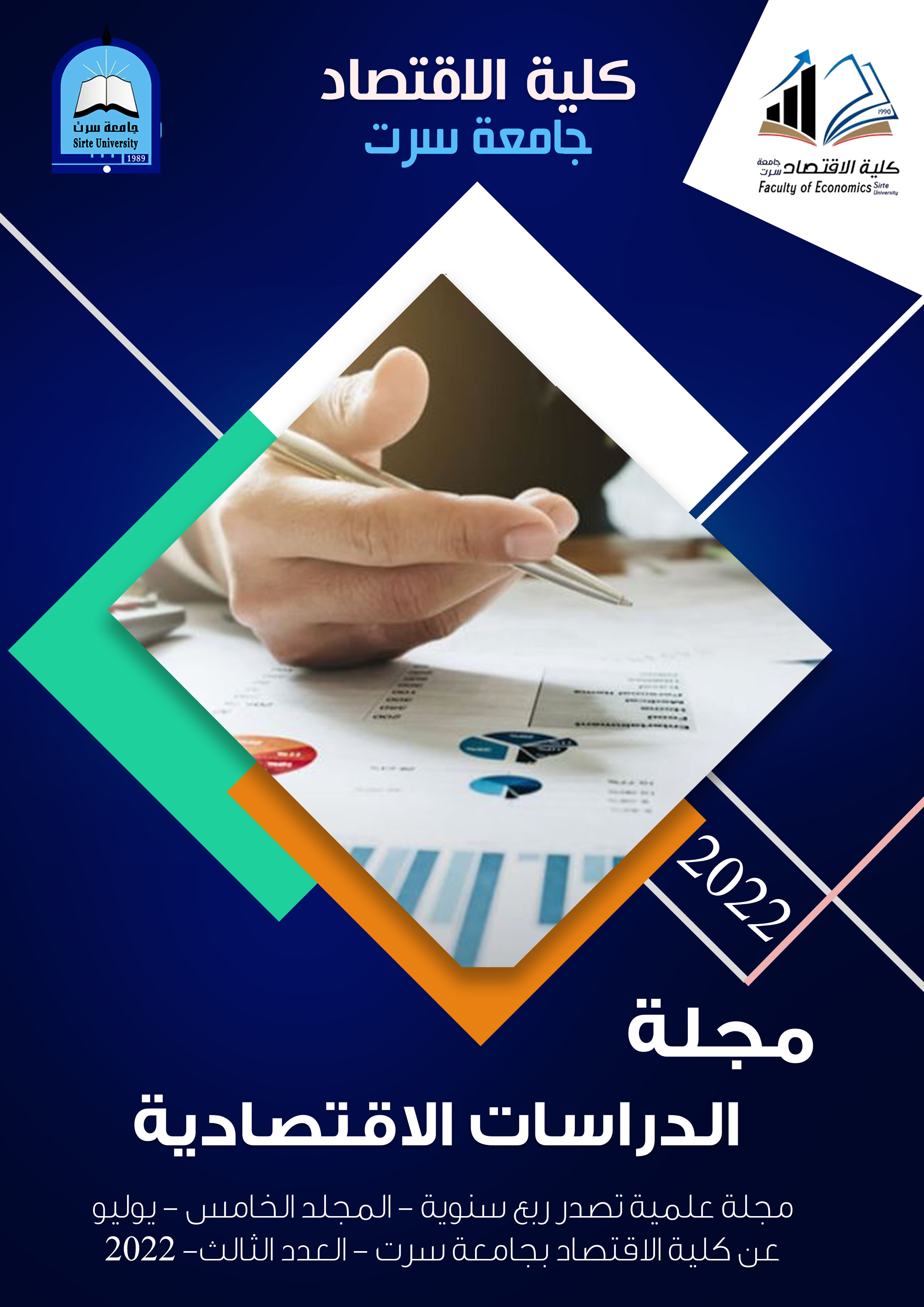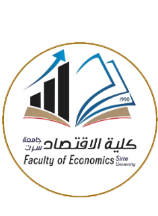النمو الاقتصادي في ليبيا وظاهرة لعنة الموارد هل يحسن الانفتاح التجاري من طبيعة المشهد ؟
DOI:
https://doi.org/10.37375/esj.v5i3.157الكلمات المفتاحية:
الانفتاح التجاري، النمو الاقتصادي، الموارد الطبيعية، الانحدار الذاتي، الاقتصاد الليبيالملخص
هدف هذا البحث لقياس أثر الانفتاح التجاري على العلاقة الرابطة بين الموارد الطبيعية والنمو الاقتصادي في ليبيا، وذلك خلال الفترة 2017-1962، ولتحقيق هذا الهدف اعتمد البحث على نموذجي الانحدار الذاتي لفترات الإبطاء الموزعة المطور، ونموذج متجه الانحدار أن الانفتاح التجاري يزيد من الأثر الإيجابي لعنصر وفرة الموارد الذاتي المطور، وقد توصل لجملة من النتائج يمكن تلخيصها في الطبيعية على النمو الاقتصادي، ويزيد من الأثر السلبي للاعتماد على الموارد الطبيعية على النمو الاقتصادي في ليبيا، وكل ذلك خلال الأجل الطويل.
المراجع
• المجلس الوطني للتطوير الاقتصادي. (2020). قاعدة البيانات الاحصائية. طرابلس.
• الهيأة العامة للمعلومات. (2007) ، قطاع الإحصاء والتعداد السلسلة الزمنية لاحصاءات التجارة الخارجية خلال السنوات 1954-2003
• الهيأة العامة للمعلومات قطاع الاحصاء والتعداد. ملخص احصاءات التجارة الخارجية، 2005 ، 2006، 2008، 2010،2017 2013 2014 2012
• الهيأة الوطنية للبحث العلمي. مركز بحوث العلوم الاقتصادية. البيانات الاقتصادية والاجتماعية في ليبيا عن الفترة 1962- 2006. بنغازي. ليبيا.
• الهيأة الوطنية للبحث العلمي. مركز بحوث العلوم الاقتصادية. قاعدة البيانات الاحصائية . بنغازي. ليبيا. http://erc.ly مجلس التخطيط العام إدارة الخطط والبرامج المؤشرات الاقتصادية والاجتماعية 1962-2000. طرابلس ليبيا.
• مصرف ليبيا المركزي النشرة الاقتصادية. المجلد 51-الربع الرابع 2014.
• مصرف ليبيا المركزي النشرة الاقتصادية . المجلد 57-الربع الرابع. 2017.
• وزارة التخطيط. .(2014). الإدارة العامة للحسابات القومية نشرة الحسابات القومية 2007-2012. وزارة التخطيط. (2019). الإدارة العامة للحسابات القومية. قاعدة البيانات الاحصائية 2012-2017. وزارة التخطيط المؤشرات الاقتصادية والاجتماعية 2000-2012.
• Ampofo, G. K. M., Cheng, J., Asante, D. A., & Bosah, P. (2020). Total natural resource rents, trade openness and economic growth in the top mineral-rich countries: New evidence from nonlinear and asymmetric analysis. Resources Policy, 68(C).
• Arezki, R., & Van der Ploeg, F. (2010). Trade policies, institutions and the natural resource curse. Applied Economics Letters, 17(15), 1443-1451.
• Bilen, C & Huzurbazar, S. (2002). Wavelet-Based Detection of Outliers in Time Series. Journal of Computational and Graphical Statistics, 11(2), 311-327.
• Castle, J. L., & Hendry, D. F. (2019). Detectives of Change: Indicator Saturation. In Modelling our Changing World (pp. 67-84). Palgrave Pivot, Cham.
• Doornik, J. A., Hendry, D. F., & Pretis, F. (2013). Step-indicator saturation. University of Oxford, Department of Economics.
• Haddad, M., Lim, J. J., Pancaro, C., & Saborowski, C. (2013). Trade openness reduces growth volatility when countries are well diversified. Canadian Journal of Economics/Revue canadienne d'économique, 46(2), 765-790. Hendry, D.F. (2000). Epilogue: The Success of General-to-Specific Model Selection, In: Hendry, Alchemy or Science? New edition. Oxford University Press, D.F. (Ed.), Econometrics:
• Iimi, A. (2007). Escaping from the Resource Curse: Evidence from Botswana and the Rest of the World. IMF Staff Papers, 54(4), 663-699.
• IMF, International Monetary Fund, The commodity terms of trade database, http://data.imf.org Kremers, J. (1986). "The Dutch Disease in The Netherlands." in Natural Resources and the Macroeconomy, eds. Neary, P. and S. van Wijnbergen, MIT Press, Cambridge, MA. Kumar Narayan, P., & Smyth, R. (2006). Higher education, real income and real investment in China: evidence from Granger causality tests. Education Economics, 14(1), 107-125. Lederman, D., & Maloney, W. F. Trade structure and growth. The world bank, Latin America and the Caribbean Region, Office of the Chief Economist, Regional Studies Program,
• Policy Research Working Paper 3025. April (2003).
• Majumder, M. K., Raghavan, M., & Vespignani, J. (2020). Oil curse, economic growth and trade openness. Energy Economics, 91, 104896.
• Mankiw, N. G., Romer, D., & Weil, D. N. (1992). A contribution to the empirics of economic growth. The quarterly journal of economics, 107(2), 407-437.
• Odhiambo, N. M. (2008). Financial depth, savings and economic growth in Kenya: A dynamic causal linkage. Economic Modelling, 25(4), 704-713.
• Odhiambo, N. M. (2009). Energy consumption and economic growth nexus in Tanzania: An ARDL bounds testing approach. Energy Policy, 37(2), 617-622.
• Olayungbo, D. O. (2019). Effects of oil export revenue on economic growth in Nigeria: A time varying analysis of resource curse. Resources Policy, 64, 101469.
• Papyrakis, E., & Gerlagh, R. (2004). The resource curse hypothesis and its transmission channels. Journal of Comparative Economics, 32(1), 181-193.
• Pesaran, M. H., & Shin, Y. (1998). An autoregressive distributed-lag modelling approach to cointegration analysis. Econometric Society Monographs, 31, 371-413.
• Pesaran, M. H., Shin, Y., & Smith, R. J. (2001). Bounds testing approaches to the analysis of level relationships. Journal of applied econometrics, 16(3), 289-326.
• Sachs, J. D., & Warner, A. (1995). Natural resource abundance and economic growth. NBER Working paper 5398.
• Sam, C. Y., McNown, R., & Goh, S. K. (2019). An augmented autoregressive distributed lag bounds test for cointegration. Economic Modelling, 80, 130-141.
• Santos, C., Hendry, D. F., & Johansen, S. (2008). Automatic selection of indicators in a fully saturated regression. Computational Statistics, 23(2), 317-335.
• Solow, R. M. (1956). A contribution to the theory of economic growth. The quarterly journal of economics, 70(1), 65-94.
• Toda, H. Y., & Yamamoto, T. (1995). Statistical inference in vector autoregressions with possibly integrated processes. Journal of econometrics, 66(1-2), 225-250.
• UN, United Nations, Statistical Database, http://data.un.org.
• WB, World Bank Database: https://data.worldbank.org/
• Yusuf, S., & Omar, M. R. (2019). Trade Openness and Economic Growth of Tanzania. Asian Journal of Economics, Business and Accounting, 12 (3) 1-10.




































